My Metaverse diary: what it’s like to live, work and shop inside the Internet

It was the ‘selfie’ mocked around the world. In the foreground was a smooth-faced digital puppet ostensibly representing Mark Zuckerberg, the chief executive of Meta (née Facebook). In the background was a miniature Eiffel Tower and some crudely rendered spherical bushes. Did Meta really spend $10 billion (£9.3 billion) last year to bring this to fruition?
The image, taken inside Meta’s flagship virtual reality (VR) app, Horizon Worlds, and posted on Instagram last month, was not a strong omen for Zuckerberg’s hopes of building ‘the metaverse’. Even Zuckerberg himself would later admit it was ‘pretty basic’. Still, having bet his company’s entire identity on the concept, and declared it his mission to ‘bring the metaverse to life’, the 38-year-old tech baron is not about to back down.
Silicon Valley has metaverse fever. According to a recent report by McKinsey, companies invested more than $120 billion in metaverse-related technology and infrastructure in the first five months of 2022, compared to $57 billion in all of 2021. The investment bank Citi predicts the metaverse could be worth up to $13 trillion by 2030. Former health secretary Matt Hancock is in on the action, becoming the first MP to have his own metaverse doppelgänger.

But what is the metaverse?
The term was coined by Neal Stephenson’s 1992 sci-fi novel Snow Crash, referring to an all-consuming digital world that could kill you if you downloaded the wrong file. Advocates imagine it as something like the next stage of the web, based not around flat pages and social-media feeds but on 3D virtual worlds. Zuckerberg called it ‘an embodied internet, where instead of just viewing content – you are in it’.
VR – which uses special goggles to put you ‘inside’ a virtual world – is central to Zuckerberg’s vision of the metaverse, along with its less solipsistic sibling, augmented reality (AR). AR uses a similar headset to layer virtual objects on to the wearer’s view of the physical world, meaning, for example, you could look at a sign in a foreign language and see it translated before your eyes. Meta hopes that the VR and AR headsets it is building will be the smartphones of tomorrow, with the latter able to accompany us everywhere we go.
The metaverse does not currently exist, and some experts think it never will. Yet many of the building blocks necessary to make a metaverse are already in place: immersive multiplayer virtual worlds have existed for decades, and modern gaming services, such as Roblox, link numerous worlds into one bustling digital economy. VR is growing quickly too, with more than 90 million people in the US expected to use it at least once per month this year.
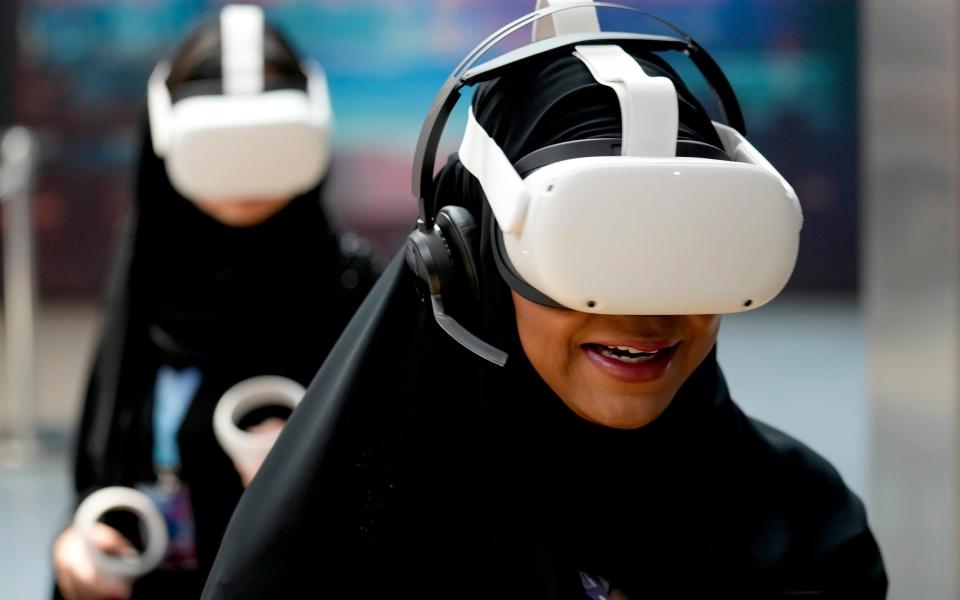
Which all begs the question, what does this proto-metaverse look like right now? What can you do there, and who will you meet? Can you actually live there in any meaningful way?
As it happens, I am unusually qualified to find out. As a nerdy teenager in the early noughties I practically grew up online, sneaking into my dad’s study every night to explore chatrooms, and learning acceptable social behaviour from elves in World of Warcraft. I was enthralled with the idea of a world unconstrained by geography or physical bodies. The internet was where I met my first spouse, made some of my most lasting friendships and did my first journalism. If anyone can live in the metaverse, it’s me.
And so, armed with Meta’s latest VR headset, the Quest 2, I ventured out into this emerging digital frontier to discover what kind of life is in store for all of us if Zuckerberg’s dream becomes a reality.
Day 1: Meditation
My week in the metaverse begins with a Buddhist meditation class.
The first thing I do is pull on my VR goggles. The Quest is a bulbous headset that fills your vision with images of a synthetic world. It works using four tiny cameras on its outer surface, which tracks its own position within real space, allowing the movements of your virtual self to mirror those of your physical body.
Look down in real life, and you’ll look down in VR; shake your head and you’ll shake your head. You also get two controllers that track the position of your hands, letting you gesture and manipulate virtual objects. In future, Meta hopes to replace these with a bracelet that decodes the electrical signals sent between your brain and your fingers.

This all feels quite natural once you get used to it. I log in to VRChat, a popular third-party ‘social VR’ app, although by the time I’ve created an account and chosen my avatar – a cartoon representation of myself, which is how others in the world will see me – I’m in desperate need of tranquillity.
Finally, I find myself in front of a beautiful Buddhist temple on a floating island in the sky. This is one of the many ‘worlds’ that make up VRChat, mostly created by players and ranging from nightclubs to mini-golf courses.
The meditation class was listed on a community calendar, but no one else is here, so I explore the island alone, moving my avatar around using the thumbstick on my left-hand controller. If I wanted, I could clear a space in my real-life apartment and physically walk around, but it’s much easier to explore sitting down. I find a bench overlooking the abyss and meditate alone, near the temple.
Soon, a small pixie-like avatar appears. It transpires that this is the meditation teacher, Creek. ‘You’re very studious!’ says Creek. ‘You’re here an hour early.’ Turns out the timings listed were incorrect.
Other attendees soon arrive, including a robot, a cartoon wolf and a person made of stars and planets, and suddenly I feel self-conscious about my humdrum human woman avatar. Too late to change it – we line up outside the temple and bow to the statue of the Buddha as we file inside, just as you might in real life.
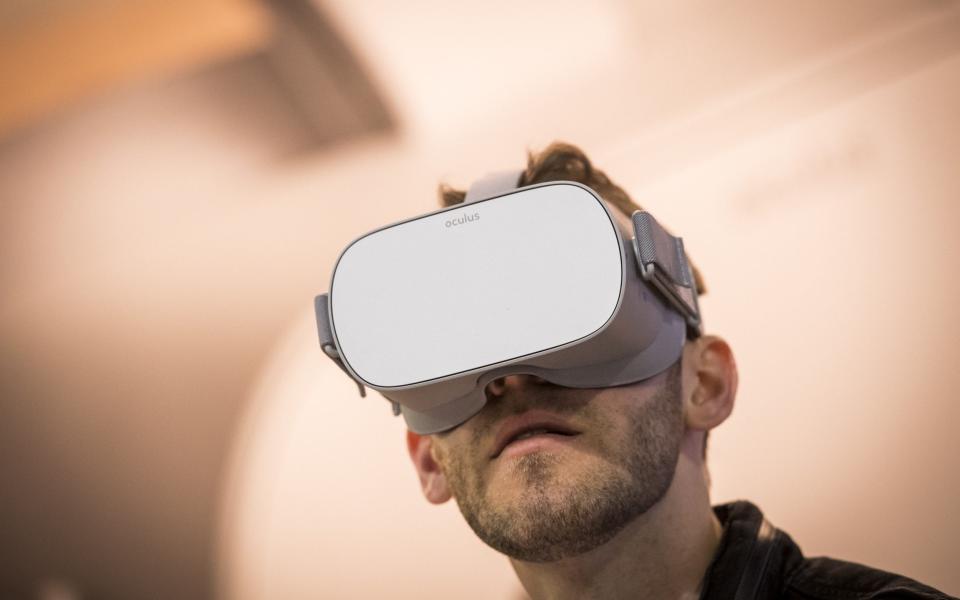
Once we’ve steadied our breathing and loosened up our real-world bodies, Creek asks us to consider what we can see, pointing out the black circles of our VR goggles around the edges of our vision, which I’ve been seeing but not noticing since I logged on. This is the weird magic of VR: as you navigate these computerised worlds, moving your head to look around, your brain quickly begins to accept them as reality. The illusion of being physically here in this temple is surprisingly powerful.
I feel calm as I teleport to my next appointment: my friend Evelyn, who in real life lives about a mile away, has invited me to go ‘world-hopping’ – basically a digital pub crawl – with her regular VR crew. First, however, she shows me VRChat’s various safety features. Sexual harassment is common in VR, involving anything from lewd comments in voice chat to people miming sexual assault by putting their hands through your avatar (which can feel very disconcerting when coupled with VR’s sense of immersion).
I decide to find a new avatar that more accurately represents me. You can either build an avatar to look however you want using 3D modelling software or simply pick a ready built one off the shelf. We stroll through virtual shopping malls trying on bizarre new shapes. I get stuck in the body of a 7ft tall buxom lion woman until my headset suddenly runs out of power. Back to reality with a bump.
Day 2: Cinema
‘I’m alive at last!’ bellows Johnny Depp, clutching a cutthroat razor in each hand. It’s Friday, and I’m in a virtual cinema watching Tim Burton’s 2007 film Sweeney Todd. VRChat has many such venues, allowing users to select from thousands of (apparently pirated) films. (My avatar body today? A green-skinned woman wearing 16th-century armour.)
Though it’s only my second day in the virtual world, I’ve already run into a disquieting number of children. ‘There’s supposed to be [a lower age limit of] 13, but I've heard children who were clearly well under 10 years old in here,’ says Lila, who organised the movie night. (Offline, she is a 28-year-old American.) ‘The parental negligence is pretty bad. I just want VRChat to add features to protect kids and adults, like age report or age verification of some sort.'

It’s a problem that VR companies are struggling to solve. VRChat bans users under 13, and requires under-18s to get parental consent to play, but there appear to be few ways of enforcing this. According to one report, a BBC journalist posing as a 13-year-old girl was able to access digital strip clubs in VRChat. The NSPCC has branded both the Quest headset and the app, created by different companies, ‘dangerous by design’. A spokesman for VRChat told me that it bans under-13s as soon as it detects them, and that the Quest allows parents to lock certain apps.
Lila listed her event as for over-18s only. ‘I love watching movies, and I wanted to give people an alternative to just getting drunk every weekend,’ she explains. She tells me that alcoholism is a problem among VRChat users, fuelled by loneliness, a lack of real-world consequences, and the social awkwardness some users still feel about virtual reality. But the ability to feel genuinely close to other people without leaving the house can be equally intoxicating. ‘I’ve known people that are plugging in almost 24/7,’ Lila says.
Some are drawn to the thrill of no one knowing who you are. For others it’s the freedom of being able to shed aspects of your offline self that you’re uncomfortable with, or finding like-minded people to spend time with. Certainly it can be more intimate and exciting than a Zoom call.
Day 3: Speed dating
It’s Saturday night, and I’m going VR speed dating. For this, I’ll need a better avatar.
A virtual billboard is advertising an online avatar-maker called Ready Player Me, so I decide to give it a go. I feed in a selfie and it uses artificial intelligence (AI) to create a digital facsimile of me. The result looks nothing like me – she’s far thinner – but who am I to argue with science?
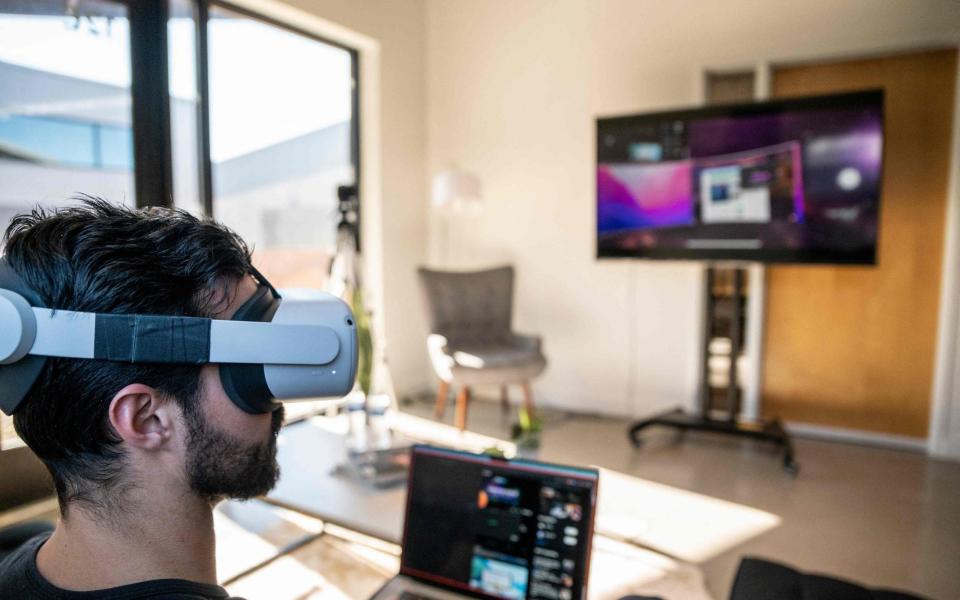
The dating venue is like a gladiatorial arena. Two people, one confined space, five minutes per date, and nothing to talk about but each other – in our real voices, as many people do in VRChat. Most of my matches are either too young, boring or painfully shy. ‘This’ll be your first time here, I’m assuming?’ says a laconic man from Bromley.
I’m no stranger to falling in love on the internet. Many of my online friendships crossed into the offline world, and I know that relationships you form online can be as real and intense as any other. Last year I travelled across America to attend the wedding of someone I met on an internet forum more than a decade earlier. Yet after a dozen or so VR speed dates, this isn’t working for me. There’s no sense of physical spark, nor any indication about what these people are like in person. Maybe you can’t replicate every aspect of the real world in the metaverse.
Day 4: Church
After all this flirting and partying, perhaps it’s for the best that today I’m going to church. The VR Church is a Christian ministry that ‘exists entirely in the metaverse’, holding services every Sunday in VRChat and another virtual world app called AltspaceVR.
‘If new people are visiting us today, thank you, O Lord, for whatever it is in their hearts that brought them here,’ says the pastor, Alina. She leads us through a series of dioramas illustrating scenes and lessons from the Book of Matthew, created specially for this week’s sermon.
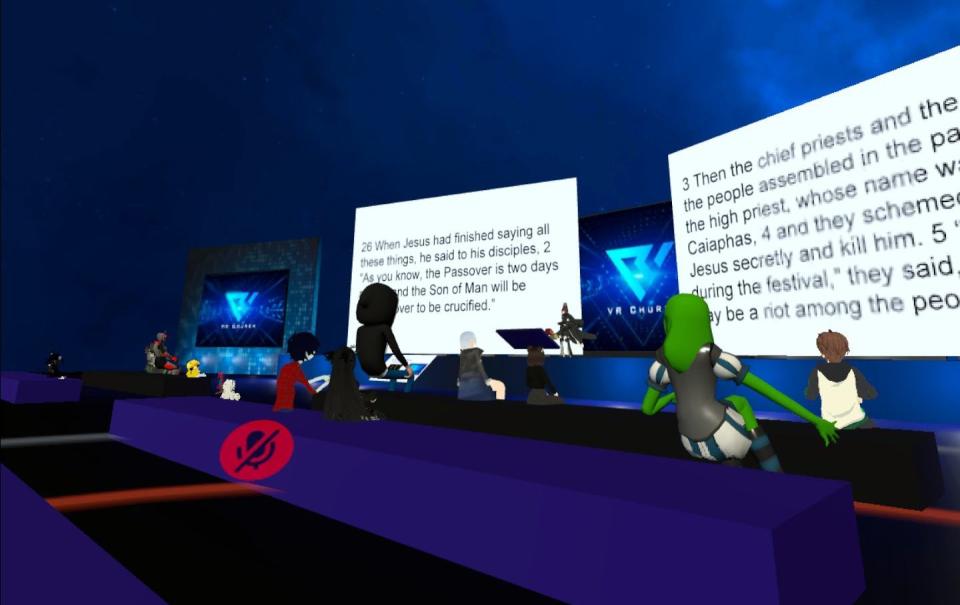
I initially attend the AltspaceVR service using my everyday laptop, but when I put on my goggles for the VRChat version I’m plunged back into the Church of Scotland of my childhood. The sense of other people sitting on all sides of me, hands clasped, is uncanny. All the weirder when the prayer ends without that collective murmur of ‘Amen’ – the other congregants must have their microphones muted.
Halfway through Alina’s sermon, two people start making trouble, donning demonic avatars. ‘We all have the power to mute and block,’ Alina tells the flock, ‘and I encourage you to use this.’
Alina, now 49, attended church regularly growing up, but her career as a flight attendant left little time for worship. Then she contracted a vascular disorder that left her fatigued and in excruciating pain. Four years ago, she found virtual reality – and the VR Church.
‘I was never into online anything prior to this,’ she tells me after the service. ‘[But] you can be satisfied in [the VR world]. You can be happy and healthy in it. I don’t feel deprived any more.’
So, does she feel you can live in VR fully? ‘Not completely – you still need to eat, sleep, and give your eyes a rest… But it absolutely can give life back to you.’
Day 5: Shopping
Zuckerberg’s dream of the metaverse may depend on VR, but that won’t be enough on its own. A successful metaverse must foster a thriving virtual economy of items and assets that can be bought, sold and transferred.
The virtual world Second Life is perhaps the closest thing we have to that vision. It launched in 2003 and today an estimated 200,000 people visit it every day to chat, shop and have cybersex. Business is conducted using a virtual currency called Linden dollars, which in turn can be bought or sold for real money. One avatar shop I visit features fantasy-style characters such as orcs and trolls for sale that cost around 2,000 to 8,000 Linden dollars apiece (roughly £5 to £22).
Bernhard Drax, a German filmmaker and contractor for Second Life developer Linden Lab, who has spent years documenting its culture, explains that players can earn real money by selling almost anything on Second Life: clothes and hairstyles for your avatar, virtual real estate and buildings, breedable pets that follow you around, or in-game work such as DJ sets or even escort services. Once a player designs an item, it can be listed on a central marketplace, or you can set up an in-game shop using land that you’ve bought – Linden Lab takes a cut of any transaction.

Second Life had its gold rush moment back in the noughties, when companies such as Adidas scrambled to build virtual shopfronts and branded items. Today its virtual economy is worth around $650 million a year. The list of categories on marketplace gives an idea of scale – you can buy anything from home and garden items to vehicles and weapons.
‘There are whole cycles of life that are met here,’ says Anya Kanevsky, vice president of product at Linden Lab. ‘There’s community, there’s interaction, there’s entertainment, there’s work, there are relationships, there’s mourning, there’s mental health support.’ On the day Queen Elizabeth II died, for example, an impromptu memorial sprung up in one of Second Life’s London-themed worlds. I visit and light a candle.
Beth*, a writer, is a regular Second Life user who has built a virtual fairground. Her avatar lives in a Second Life house, built next to the train line that ferries avatars from place to place. It has a bathroom with scales that tell you how system-intensive your avatar is (it’s considered rude to unduly burden other people’s computers) and a miniature Blade Runner-style dystopia in the backyard. We put on some Beethoven, pour virtual drinks and chat.
For Beth, Second Life was a safe place to begin developing an independent sense of self after the death of her adoptive mother. She says many people end up growing to resemble their avatars in real life as they test out new identities here before adopting them elsewhere. Drax similarly says people are often unconsciously drawn, when creating an avatar to, things they need to express or explore. ‘It’s magical sometimes, honestly,’ he says.
Day 6: Working
With deadlines looming, it’s time to do some real work. Zuckerberg has long talked up the metaverse as a supplement or perhaps even a replacement for the office, with VR and AR headsets letting colleagues appear in your home like Star Wars holograms.
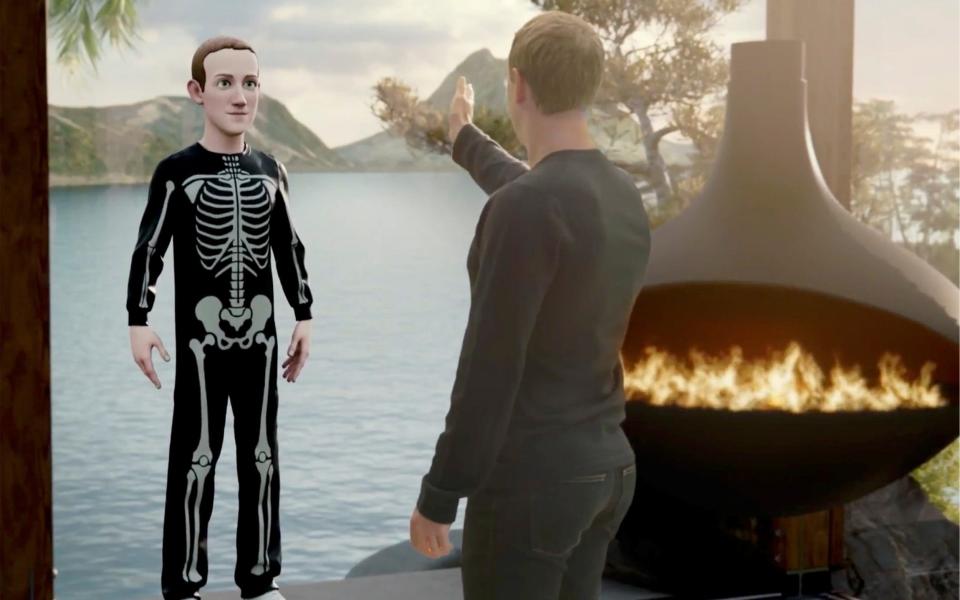
With a little effort I’m able to set up a virtual desk in Meta’s VR meeting app, Horizon Workrooms, and connect it with my actual work PC. Pleasingly, Horizon’s avatar maker is the first I’ve tried that lets me choose a body with proportions like my own (dumpy – or curvy if you’re being nice). The Quest 2’s finger-tracking function allows me to manipulate objects by moving my actual hands, but the virtual monitor is blurry and hard to look at too long.
The bigger problem is Jackie, a rambunctious (real life) rescue mutt that I’ve been dogsitting for a friend. Every 15 minutes she comes snuffling at my lap wanting me to hide her little rag doll so she can hunt it, and I can’t oblige without taking off my headset. Imagine trying to do this with a human child in the house.
Still, I write. I transcribe interviews. I check my emails. I put off answering my emails. I read a report claiming that Meta’s VR division is bracing for cutbacks after losing $5.8 billion in the first half of this year. I tweet. I answer my emails. It’s a normal day at the home office, only far more uncomfortable. Why would anyone do this?
To be fair, Workrooms isn’t built for sustained toil. It’s meant as an alternative to Zoom calls, allowing you to feel more connected with remote colleagues. Alas, my editor is busy and no one on Twitter fancies a VR business meeting.
Day 7: Nightlife
On my last day in the metaverse I explore Meta’s VR social app, Horizon Worlds, which Zuckerberg hopes will function as a ‘social fabric that goes across all the different layers of virtual reality’. According to Meta, Horizon Worlds had 300,000 active users in February; far fewer than rival app Rec Room, which has an estimated three million a month.
I find myself on stage in a replica of Shakespeare’s Globe, performing a scene from Much Ado About Nothing with my friend Ted. (We used to meet up in person, but now he has moved away, this is a good place to catch up.)

But the atmosphere becomes livelier when we visit a comedy club; Ted gets on stage. Someone hands me a gigantic cigar. Later, we go to a nightclub called the Chicago Penthouse, which feels just like a real nightclub as the music is too loud to hear what anyone is saying.
Just as Ted’s headset crashes, I’m cornered by a man wearing a blazer and pocket square, who tells me he’s here doing research to build his own virtual world. I leave…
The biggest question I had at the start of my week is what the metaverse will look like when it properly exists. Many firms are trying to build metaverses based on cryptocurrency, where everything is a financial asset that you can speculate on (or lose your life savings on). Anya Kanevsky, the Second Life developer, is sceptical that VR will be central. ‘I don’t know that everybody wants to be virtually present somewhere. This is not everybody’s cup of tea,’ she says. Other pioneers argue that AR will end up far more important.
As for me, I’m captivated by the feeling of being able to go somewhere new even when I’m feeling tired or lazy – to get ‘outside’ without actually leaving the comfort of home.
Given that the pandemic has changed our lives already, with many workplaces already virtual, perhaps it will catch on sooner than we realise. And if Zuckerberg is even halfway right, it will be as difficult to avoid the metaverse as it is to dodge social media. Though what will it look like by then, and whose interests it will really serve, remains to be seen.


